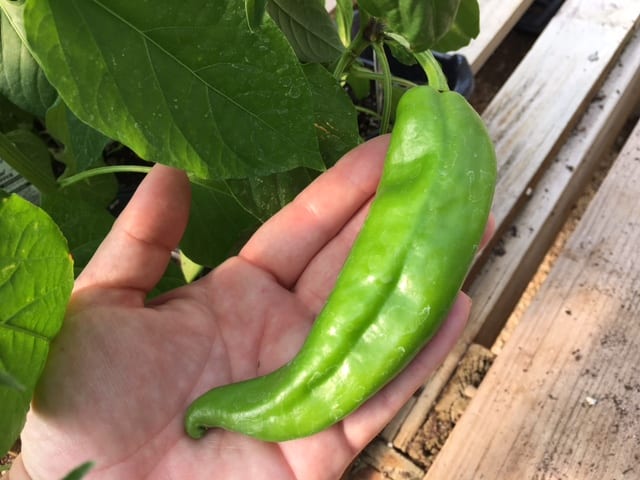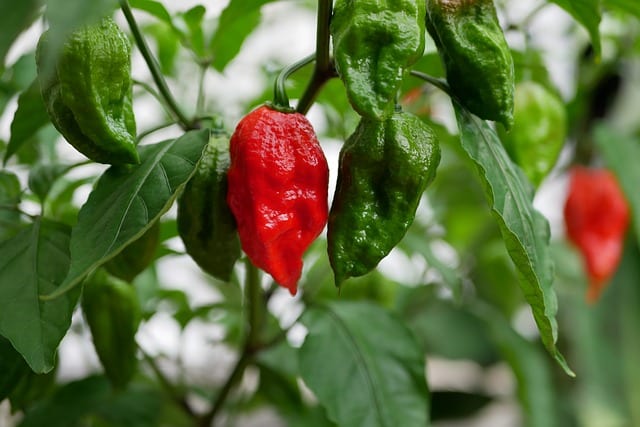It’s time to plant another batch of peppers! Although native to tropical regions in the Americas, we are fortunate to be able to grow them in San Antonio, Texas, during both spring and fall.
Peppers come in a wide range of sizes, from the small Chili Pequin to the large Big Jim Anaheim pepper. The spiciness level of peppers also varies greatly. You could enjoy a Sweet Chocolate Bell pepper without needing a glass of milk nearby, or take a small bite of a Ghost pepper that might bring tears to your eyes. Let’s celebrate peppers today.
Most peppers typically grow to an average height of no more than three feet when fully mature. They especially grow well in containers and raised beds as this helps achieve the well-draining soil they need. That’s great news for those with smaller landscapes or those who only have a small patio or balcony to grow vegetables.

Growing Peppers
These self-pollinating plants usually bear fruit when nighttime temperatures range between 55°F and 80°F, with daytime temperatures not exceeding 95°F. At temps over 95°F, it’s generally smaller peppers that may still keep producing, while larger varieties may drop their blossoms, but they’ll pick back up again once temps cool off a little bit. We got a tip once from Vegetable Specialist and Master Gardener, Karen Gardner, that spraying the entire pepper plant with water in the heat of the day just might help peppers produce even more! Might as well try it.
In San Antonio, getting peppers started in early fall should give you fruit before the first freeze rolls about. Early plantings in spring give you a harvest before the summer rages in with its heat. Just make sure the soil has warmed enough, or the plant can become stunted and unproductive.
To ensure healthy growth, provide peppers with:
- 6-8 hours of full sunshine.
- well-draining soil that has a depth of at least 12″-15″. In ground plantings should have soil that’s been amended with compost or other rich, organic matter. Choose a quality potting mix with beneficial soil microbes (like FoxFarm Happy Frog) for container plantings.
- 18-24″ of space between each planting (and about 3′ of space between rows).
- slow release fertilizer mixed into soil at planting (like Osmocote or
Espoma Garden-Tone) following label instructions. - supplemental liquid fertilizer every other week (Medina Hasta Gro Plant, or FoxFarm Big Bloom once flowers appear).
- 1-2″ of water weekly (more when it is extremely hot, as moist soil is crucial).
- 2″ layer of mulch to keep soil moist and roots cooler.
- a cage or stakes to support plant once it starts to bear peppers.

Harvesting Peppers
Harvest peppers often as that actually encourages the plant to produce even more fruit.
Use a sharp knife, pruners, or scissors to cut peppers at the stem when harvesting, leaving a little bit of the stem on the pepper and a little on the plant. Trying to pull the fruits off by hand may cause limbs to easily break.

Eating Peppers
Oh boy, here comes the best part. Although, when you think about it, the plants with their colorful fruits are beautiful enough to just grow them as ornamentals. But goodness there are a lot of ways you can enjoy peppers. They can be eaten raw, pickled, sauteed, roasted, stuffed, dried, and probably another dozen ways.
I recently saw a little blurb on social media that you can freeze peppers whole and use a fine grater to shave little bits on the top of your dishes. I just love this idea.
Just a reminder when handling those hotter varieties. Watch out for the seeds, and inside ribbings and veins! Best to use gloves when handling them, as the oily compound in those areas can seep into your skin. And it stays there for awhile too! If you’ve ever forgotten you just touched a pepper and then rubbed your eye, you know what I’m talking about. Use caution. It’s no joke.
Come on out this early fall and see what peppers we’ve brought in for you at either of our two Rainbow Gardens locations. We’re sure to have a pepper for your tastebuds.
~The Happy Gardener, Lisa Mulroy


Hello. I brought a Tabasco Pepper plant back in June of this year and it only produced a couple of peppers. What can I do to make it produce more?
Thanks!
Hi Thomas,
If you live here in Texas, it could be that it was planted in summer and we are currently experiencing (and have been) high temperatures. I bet your plant will start producing some flowers and fruit once the temps start to cool down for fall. But, you can: make sure you’re plant is getting plenty of water, feed it (they are hungry plants) with a slow-release fertilizer like Espoma Garden-tone, and then supplement with a liquid fertilizer every 2-3 weeks. Foxfarm has a good liquid fertilizer called Grow Big for vegetative growth, and then once your pepper produces flowers, you can switch to a liquid fertilizer like FoxFarm Big Bloom, that supports growth of blooms and fruit. Or find a fertilizer that is comparable (higher nitrogen number for vegatative growth, higher phosphate number for flower and fruit production.) Hang in there, cooler are days are around the corner.
I have a chili pequin growing in a container on my patio which is doing quite well despite the heat. Would it be possible (advisable) to transplant it directly into the ground in early fall in hope it might “naturalize”? Thanks, James M. (Lytle)
Hi James,
Absolutely you can do that, but definitely wait until the temperatures ease up a bit in fall like you stated. Cut back about 1/3 of the plant so the energy goes to developing roots. You can use a little root stimulator to help it get going, but you shouldn’t really need fertilizer for these native peppers. Best of luck!